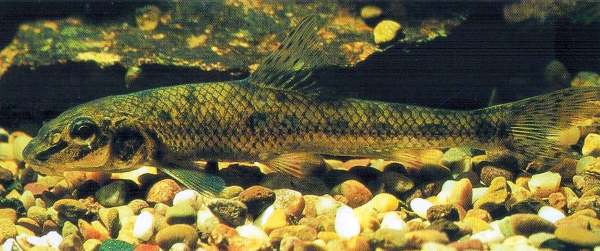Gobio gobio - Gudgeon
Phylum: Chordata - Class: Actinopterygii - Order: Cypriniformes - Family: Cyprinidae

Commonly found in canals, ponds and slow to moderately fast-flowing streams, gudgeon are very adaptable and among the more tolerant of fishes to disturbance - for example from passing boat traffic. They often shoal and invariably remain on the bottom, where their mouths are ideally adapted for grubbing for food in the silt. Bloodworms, the larvae of Chirononmid midges ( non-biting midges not those other little pests!) are the staple diet of these relatively short-lived coarse fish. (They rarely live to be much older than five or six years.)
These small, barbel-like cyprinids (carp family) fish rarely grow to more than eight inches (20cm) in length and most mature at around half that size. They spawn between April and July, are often a young angler's first introduction to the thrills of fishing. Gudgeon have two barbules at the side of the mouth, whereas barbel have four - a useful identification feature if in doubt whether you have caught a gudgeon or a small barbel.
The British rod-caught record gudgeon, a 5oz (0.141kg) specimen was caught on the River Nadder, in Wiltshire by Mr D H Hull in 1990.
Acknowledgements
This page includes pictures kindly contributed by Dr Nick Giles.
Excited at the prospect of flyfishing? So are we, and we're pretty sure you would find the Winding River Mystery trilogy of action-packed thrillers gripping reading too. Dead Drift, Dead Cert, and Dead End are Pat O'Reilly's latest river-and-flyfishing based novels, and now they are available in ebook format. Full details on our website here...
Buy each book for just £4.96 on Amazon...
Please Help Us: If you have found this information interesting and useful, please consider helping to keep First Nature online by making a small donation towards the web hosting and internet costs.
Any donations over and above the essential running costs will help support the conservation work of Plantlife, the Rivers Trust and charitable botanic gardens - as do author royalties and publisher proceeds from books by Pat and Sue.
